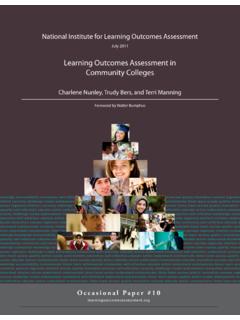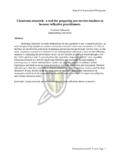Transcription of Linking children’s literature with social studies in …
1 Journal of Instructional Pedagogies Linking children s literature , page 1 Linking children s literature with social studies in the elementary curriculum Gina M. Almerico The University of Tampa ABSTRACT The author shares information related to integrating quality literature written for children into the teaching of social studies at the elementary school level. Research within the past decade informs educators of the strong impact of curriculum standards for the social studies as developed by professional organizations. Teachers today are expected to teach the social studies content defined by these standards. The most noted standards are those developed by the National Council for the social studies (NCSS). The NCSS supports using of children s literature in teaching and reinforcing social studies content. In this paper, instructional methods for sharing quality children s literature aligned to the NCSS Standards will be explored.
2 Keywords: literature integration with social studies , strategies for teaching social studies with literature Copyright statement: Authors retain the copyright to the manuscripts published in AABRI journals. Please see the AABRI Copyright Policy at Journal of Instructional Pedagogies Linking children s literature , page 2 WHAT IS social studies ? Although social studies has been part of the elementary school curriculum for decades, it is not an easy subject to describe. George Maxim (2010) defined social studies as a label for a school subject that brings together the social sciences in a coordinated, systematic fashion to help young people become citizens in a culturally diverse, democratic society. social studies is multifaceted and can be broadly defined as those parts of the curriculum derived from history and the social science disciplines of geography, economics, political science, sociology, and anthropology.
3 THE NATIONAL COUNCIL FOR THE social studies The leading national professional organization dedicated to the teaching of social studies is the National Council for the social studies (NCSS). The mission of the NCSS is to provide leadership, service, and support for all social studies educators. It is the largest association in the country devoted solely to social studies education. The NCSS (1997) defined social studies as "the integrated study of the social sciences and humanities to promote civic competence." Within the school program, social studies provides coordinated, systematic study of the disciplines of anthropology, archaeology, economics, geography, history, law, philosophy, political science and civics, psychology, religion, and sociology, as well as appropriate content from the humanities, mathematics, and natural sciences.
4 In 2010, the NCSS revised their original standards and published National Curriculum Standards for social studies : A Framework for Teaching, Learning, and Assessment. The revised standards, structured around the ten themes of social studies , recommend a sharper focus on purposes, questions for exploration, knowledge (what learners need to understand), processes (what learners will be capable of doing), and products (how learners demonstrate understanding) (National Council for the social studies 2010). social studies decision makers in K-12 schools can use the NCSS standards to develop and promote an integrated social science, behavioral science, and humanities approach for achieving academic and civic competence with their students. The ten (10) themes of the NCSS framework incorporate fields of study that correspond with one or more relevant disciplines.
5 The organization believes that effective social studies programs include experiences that provide for the study of: Culture This theme focuses on the fact that humans create culture as a way of making sense of their social and physical worlds. The theme has a strong relationship to anthropology. Time, Continuity, and Change This theme helps students understand that change is inevitable, although there is some continuity and the past does influence the present. People, Places, and Environments This theme helps students understand that people live in varied environments. Uniqueness of place is reflected in the interaction between people and the environments in which they life. This primarily geographic theme relates to concepts such as location and spatial interaction. Individual Development and Identity This theme focuses on the importance of individual development and the relationship of individuals to others that inhabit their social world.
6 This theme helps individuals consider how their own identity was formed and how it influences their outlooks and values. This theme is drawn from social psychology, sociology, and anthropology. Journal of Instructional Pedagogies Linking children s literature , page 3 Individuals, Groups, and Institutions This theme helps students understand that humans are social beings that seek membership in groups. They create social institutions to help them meet needs. Institutions and groups strongly influence their norms, values, and behavioral expectations. This theme is related primarily to sociology. Power, Authority, and Governance This theme is central to the development of civic competence. studies in this theme deal with power and addresses how it acquired, by whom, and how it is used. This theme is drawn primarily from political science and civics.
7 Production, Distribution, and Consumption This theme is primarily related to economics. It helps students understand concepts such as wants, needs, scarcity, human resources, capital resources, and opportunity costs. Science, Technology, and Society This theme helps students understand the great influence that science and technology exert on social and cultural change. To reach educated conclusions and make informed predictions about the future, students need a strong understanding of the influence of science and technology. This interdisciplinary theme covers nearly all of the social science disciplines including history, geography, economics, sociology, and anthropology. Global Connections This theme helps students understand that improvements in technology and transportation have increased the interconnectedness of the entire world.
8 Events that happen in one part of the world influence all of us. Students need to understand that decisions made as citizens will have global consequences. This theme also crosses all disciplines. Civic Ideals and Practices This theme encompasses one of the major responsibilities of the social studies . The function of this theme is to stress the need to develop civic competence. This theme has a direct relationship to political science, civics, and history. THE IMPORTANCE OFINCORPORATING literature INTO THE social studies CURRICULUM children s literature is often an unexplored option in the social studies curriculum; it is acknowledged in the research that good books have the potential to allow children to make personal connections to the topic being studied. Information found within the pages of a good book be it fiction or nonfiction can transport readers/listeners to another time place, or situation.
9 social studies learning can be enhanced in the curriculum through using and discussing carefully selected literature . In their book, The Power of Picture Books in Teaching Math, Science, and social studies , Columba, Kim, and Moe (2009) discussed the importance of using literature in content area instruction. children s books can provide authentic chances for readers or listeners to find themselves in the characters they meet and the situations that unfold before them. Carefully selected quality literature has the ability to elicit unique emotions and responses to stories from children and to transport them into a different time or place. They believe social studies concepts can be learned through the interaction between what the students bring with them to the reading knowledge-wise and what they learn by reading and discussing the stories and information in trade books.
10 The teacher s role in using literature in the social studies classroom, according to Columba, Kim, and Moe is to be a facilitator who determines what and how to teach in a climate of cooperation and sharing. Journal of Instructional Pedagogies Linking children s literature , page 4 Shiveley (2003) found that in recent years teachers and school districts have initiated using children s literature as the primary, or in some cases, the only resource in teaching social studies content. He supported this statement citing that more and better children s books have been published that address the themes in the social studies in a relevant meaningful manner. Teachers have abundant resources from which to select in creating social studies lessons based on quality children s books. Krey (1998) summarized the benefits of using trade books in the teaching of the social studies citing that trade books: 1.















